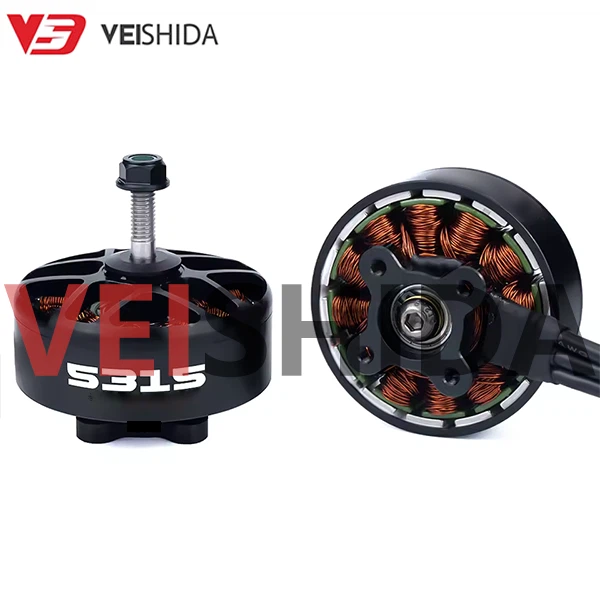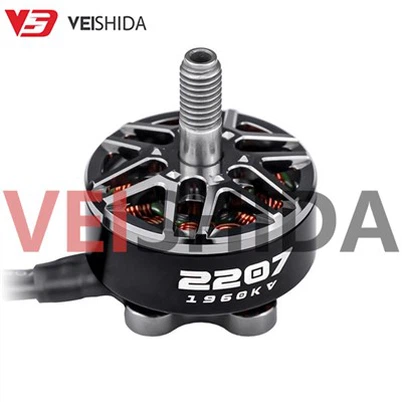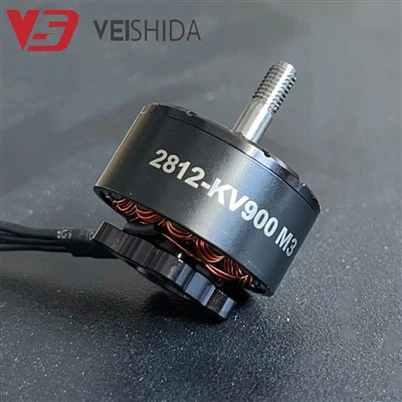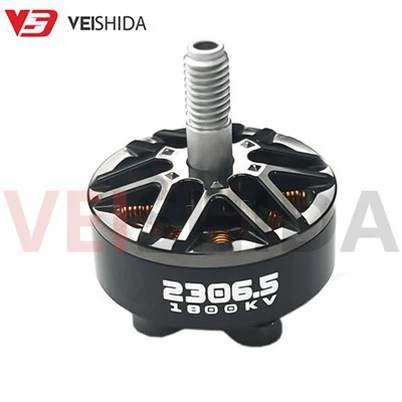What is the KV value of drone motors
Leave a message
From structural principles to performance parameters, KV value is an inevitable step
In the previous articles, we have had a preliminary understanding of the structure and working mode of drone motors: most drones use brushless DC motors (BLDC), which have obvious advantages in control accuracy, efficiency and stability, far surpassing brushed motors and traditional AC motors.
However, when it comes to selecting a model, many people will find that even though they are all brushless motors, there are significant differences between them, and one of the most direct and frequently mentioned indicators of these differences is the KV value.
You may have seen parameters such as "2306 2400KV" on product labels, or heard that "high KV is suitable for racing, low KV is suitable for aerial photography." But what exactly does the KV value mean? Is the higher the better? And how can you choose the right KV according to your needs?
This article will take you from the basic concepts to truly understand the logic and application significance behind the KV value.

What is KV value? Definition and calculation method
1. Definition of KV value
KV value, the full name is "speed constant" (RPM per Volt), the unit is "RPM/V", which means:
"The speed (RPM) that the motor can achieve when 1V voltage is applied when the motor is unloaded"
In other words, the higher the KV value, the faster the motor will turn per unit voltage.
For example:
A motor rated at 1000KV will have a no-load speed of about 10,000 RPM when 10V is applied;
A 2300KV motor at 10V has a no-load speed of 23000 RPM.
Please note: "No load" refers to the free rotation state of the motor without propellers and load. In actual use, due to factors such as load and air resistance, the speed will be lower than the theoretical value.
2. KV value ≠ power size
Many people mistakenly believe that a high KV value means "strong power", but this is actually a misunderstanding. The KV value essentially reflects the relationship between voltage and speed, rather than the output power or thrust of the motor itself.
What really determines the output capacity of the motor are:
Motor input voltage and current (power = voltage × current)
The torque constant and structural dimensions of the motor (such as magnet strength and number of coil turns)
Propeller size and load matching
3. What are the factors affecting KV value?
The KV value is determined by the internal structure of the motor, mainly including:
Number of coil turns: The more turns, the lower the KV (but the torque is usually higher);
Magnet strength: The stronger the magnetic field, the higher the speed per unit voltage;
Core size: The rotor radius and thickness will affect the change in magnetic flux, which in turn affects KV;
Stator structure: The pole number design will also affect the KV and torque balance.
During the manufacturing process, the KV value can be fine-tuned by adjusting the coil parameters and magnetic circuit structure, and therefore becomes one of the important parameters that motor manufacturers such as VSD can provide customization.

Relationship between KV value, speed and torque
The KV value is not only a parameter of the motor speed, but also determines the output characteristics of the motor at a deeper level - it will directly affect the response speed, load capacity and flight style of your aircraft.
1. High KV motor: high speed response, suitable for light load and fast flight
High KV means that the motor has a higher no-load speed at the same voltage, quicker response, and more flexible instant take-off and direction change. This makes it very suitable for scenarios that require fast acceleration and fine control.
But at the same time, the torque output of high KV motors is relatively low and is not suitable for carrying large propellers or heavy loads. Otherwise, it is easy to cause reduced efficiency, severe heat generation and even ESC overload.
Note: This is a common rule in motor construction, the higher the speed, the lower the torque.
Application scenarios:
FPV Drone
Aerial confrontation flight, multi-turn agile aircraft
2. Low KV motor: high torque drive, suitable for stable and long-lasting flight
Although low-KV motors have relatively slow rotation speeds, they have greater torque capabilities due to the large number of coil turns and strong magnetic field strength, and can easily drive large propellers or carry heavier equipment.
This type of motor is widely used in aerial photography, surveying and mapping, logistics and other scenarios. It emphasizes flight stability, wind resistance and load capacity rather than maximum speed.
Application scenarios:
Multi-rotor aerial photography drone
Industrial inspection, load platform drones
Long-endurance missions
3. When selecting the KV value, you cannot just look at the value, but also need to make a comprehensive judgment based on "propeller blades, voltage, and load".
In actual motor selection, KV value is never an isolated parameter, it is always "used in conjunction" with the following factors:
Battery voltage (such as 4S/6S/8S): The higher the voltage, the higher the motor speed at the same KV;
Propeller size and type: large propellers are suitable for low KV, small propellers are suitable for high KV;
Total weight and load requirements of aircraft: choose low KV for high load and high KV for light aircraft;
Flying style: Choose high KV for racing, and low KV for aerial photography.
For example, for the same 2306 motor:
2400KV with 5-inch propellers, suitable for rapid flight of drones;
1800KV with 6-inch propellers is more suitable for stable endurance crossing or long-distance flight missions.

How to choose KV value according to flight requirements
When choosing a motor for a drone, it is not enough to understand the KV value. The key is to learn how to match the appropriate KV range according to your flight goals. The following are three common flight scenarios and selection suggestions:
1. Cross-country racing drones: high KV, light burst
Goal: Pursue speed, agile response, and varied aerial movements
Recommended KV range: 1800KV ~ 2400KV
Recommended package: 5-inch or smaller lightweight propeller + 4S/6S battery
Representative motor:
VSD 2306 Brushless Motor: 1800KV / 1960KV / 2400KV
VSD 2207 brushless motor: 1960KV
2. Aerial photography and multi-rotor platforms: medium to low KV, stable and efficient
Goal: Emphasis on flight stability, wind resistance and flight time
Recommended KV range: 700KV ~ 1200KV
Recommended package: 10-inch ~ 15-inch propeller + 6S8S battery
Representative motor:
VSD 2812 brushless motor: 900KV
VSD 2808 Brushless Motor: 1300KV / 1500KV
VSD 3115 brushless motor: 900KV / 1050KV / 1520KV
3. Industrial-grade load and long-duration missions: low KV, high thrust and strong drive
Target: Carrying heavy equipment such as cameras, radars, cargo, etc., stable flight or long-term inspection
Recommended KV range: 300KV ~ 500KV
Recommended package: 15-inch ~ 18-inch propeller + high-voltage battery pack (6S~12S)
Representative motor:
VSD 4720 brushless motor: 420KV
VSD 5315 brushless motor: 380KV
So what you need to remember is: KV value is not "the higher the better" or "the lower the more stable"
If the KV value is too high, if the load is too heavy and the voltage is too low, the system will not be able to perform well and may overheat and burn out easily.
If the KV value is too low, the thrust may be insufficient when used with small propeller blades, or even fail to take off;
Motor selection should be evaluated in combination with flight control, ESC, battery, current limit and overall design. It is recommended to refer to the manufacturer's matching recommendations or thrust test data.

VSD KV value customization service advantages
This article introduces the definition, function and selection points of the KV value of drone motors. As a key parameter of motor speed and voltage, the KV value directly affects the performance of the aircraft. Choosing a suitable KV value will help improve the efficiency, stability and flight experience of the drone.
VSD-Professional Drone motor Manufacturing Partner
As a company focusing on the R&D and manufacturing of brushless motors, VSD has a number of core patents and a strict quality management system to ensure the high performance and high reliability of each motor. Our advantages include:
The rich product line covers a variety of KV values and voltage ranges to meet diverse needs from racing to industrial level;
Advanced R&D capabilities, with multi-dimensional customization capabilities, including KV value, size, structure and performance parameters;
A complete testing system ensures the stability and durability of the motor under different working conditions;
Professional technical support team, providing full-process services, from model selection consultation to later technical support;
With international certification qualifications, our products are exported to Europe, America and the global market and are widely trusted by customers.
Whether it is a small-batch trial production or large-scale mass production, VSD can flexibly adjust the KV value and other parameters according to customer needs to help you achieve the best match and improve product competitiveness.
Welcome to contact us to learn more about VSD drone motor customization service details and let professional help you realize your flying dream.








